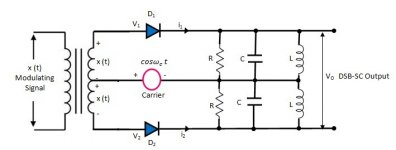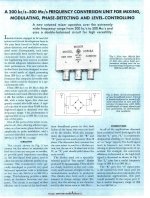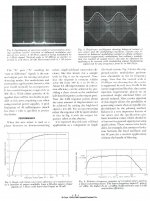I tuned this amp mostly by listening to it. It works OK with no FB but sounded too bright to me. I picked 300K for the FB because that's what sounded best after experimenting, but some folks with less bright speakers have said they like something closer to 600K. I also tried wiring this with the EL34 triode strapped and it sounded too dull for my taste. I tried both just a cathode resistor, and then cathode resistor with a bypass cap, and finally the LED/resistor combo on the 6SQ7 and again, it sounded best to me with the LED/resistor.
I have no idea what a simulator of the amp would show etc., but I can say with no hesitation, this amp using these 15W Edcor transformers sounds really sweet, puts out reasonable power and has appropriate input sensitivity for an integrated amp running off modern sources. People who have built it are saying the same, they really like how it sounds.
I have no idea what a simulator of the amp would show etc., but I can say with no hesitation, this amp using these 15W Edcor transformers sounds really sweet, puts out reasonable power and has appropriate input sensitivity for an integrated amp running off modern sources. People who have built it are saying the same, they really like how it sounds.
Here is a hybrid example of that.jhs has pointed out earlier that "Schade" feedback is well suited to a pentode driver stage. In semicon terms this is called a transconductance-transadmittance design. Never really took off in semicon amps but is finding a home in vacuum valves.
All good fortune,
Chris
Attachments
-
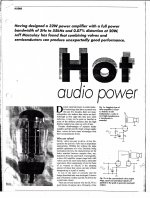 Transimpedance & Transconductance in Experimental Amplifier p1.jpg508.8 KB · Views: 192
Transimpedance & Transconductance in Experimental Amplifier p1.jpg508.8 KB · Views: 192 -
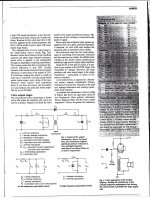 Transimpedance & Transconductance in Experimental Amplifier p2.jpg621.9 KB · Views: 193
Transimpedance & Transconductance in Experimental Amplifier p2.jpg621.9 KB · Views: 193 -
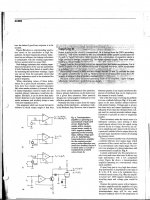 Transimpedance & Transconductance in Experimental Amplifier p3.jpg562.7 KB · Views: 177
Transimpedance & Transconductance in Experimental Amplifier p3.jpg562.7 KB · Views: 177 -
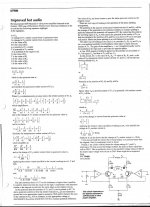 Transimpedance & Transconductance in Experimental Amplifier p5.jpg431.4 KB · Views: 184
Transimpedance & Transconductance in Experimental Amplifier p5.jpg431.4 KB · Views: 184
That was an interesting article, but I think a bit was missing. Looks like there should be a bit after page 3, and before the Letters.
Get the original at this link-
https://worldradiohistory.com/Wireless_World_Magazine.htm
The Wireless World tab, go down to 1995, the article is on p856 of the October issue.
https://worldradiohistory.com/Wireless_World_Magazine.htm
The Wireless World tab, go down to 1995, the article is on p856 of the October issue.
Regarding Schade feedback from a post on audiokarma Paul Kegger mentioned tests done in the SE in the various configurations, UL pentode and triode. In principle it states that use in all three is not prohibited, with greater benefit in the case of pentode and UL. In my case I recently made an SE with KT88 (Abdellah / Gendrano) in triode. Due to led cathode biasing, it is not possible to adopt LNFB between cathode and output, I opted for the Schade. Sonically I don't hear any adverse effects, quite the contrary. Soon maybe I will post the project in the gallery.Here is a hybrid example of that.
Anyway, I'll read your attached files.
I would also suggest playing around with the value of the SFB resistor. In triode mode, I found that amp sounded better with a higher value resistor, something around 470K. At the end of the day my take on all of this is "Does it sound good?"In my case I recently made an SE with KT88 (Abdellah / Gendrano) in triode. Due to led cathode biasing, it is not possible to adopt LNFB between cathode and output, I opted for the Schade. Sonically I don't hear any adverse effects, quite the contrary.
Yes it's just the value I used to for A. to A. after some sonic trials. Also, I'm planning to modify the anode resistor with CCS beause I'm currenty using the 6n2p (maybe not the best tube for the job, but I felt the ECC85 not better), according to Stefano Bianchini suggestion:
https://www.sb-lab.eu/amplificatore-se-con-valvole-kt88-6550-e-ecc85-6aq8/
(Sorry for the italian article)
https://www.sb-lab.eu/amplificatore-se-con-valvole-kt88-6550-e-ecc85-6aq8/
(Sorry for the italian article)
LEDs, How Do They Fit Into The Audio Path? My Recollections, Anyway
The Geezers who developed all these audio circuits we use today would have avoided putting a diode into their amplifier audio path as if the plague resided there. There were no LEDs but plenty of other SS diodes to choose from. For the most part they served as rectifiers in audio amplifiers.
In the late 70s we were selling TI RED LEDs by the Million at prices like 6 cents US each. Back in the HP SS lab an over curious engineer got the idea, why not try LEDS in Ring Modulators & Balanced Modulators. We were selling thousands of small Schottky diodes into applications of this kind. The unofficial report that leaked out of the lab claimed the LEDs tried worked reasonably well.
A simple Modulator of two diodes configured the same as a common CT rectifier can convert audio onto a carrier were none of the carrier signal is left. It is called Balanced, Suppressed Carrier, the remaining sidebands contain all the audio information. There are others based on a ring of four diodes, such as used in the HP 10514A.
The signal produced is the same as that which carries the difference (L-R) information required for analogue FM stereo broadcast. The suppressed carrier is on the FM signal just above the main signal which is the L+R information. All accomplished by the non-linearity of a group of diodes.
With all that going on, does a LED Diode make sense in the signal path of your amplifier? Looks like it will generate some distortion & intermods.
When & where did this odd circuit addition originate? And why do people follow it blindly?
The Geezers who developed all these audio circuits we use today would have avoided putting a diode into their amplifier audio path as if the plague resided there. There were no LEDs but plenty of other SS diodes to choose from. For the most part they served as rectifiers in audio amplifiers.
In the late 70s we were selling TI RED LEDs by the Million at prices like 6 cents US each. Back in the HP SS lab an over curious engineer got the idea, why not try LEDS in Ring Modulators & Balanced Modulators. We were selling thousands of small Schottky diodes into applications of this kind. The unofficial report that leaked out of the lab claimed the LEDs tried worked reasonably well.
A simple Modulator of two diodes configured the same as a common CT rectifier can convert audio onto a carrier were none of the carrier signal is left. It is called Balanced, Suppressed Carrier, the remaining sidebands contain all the audio information. There are others based on a ring of four diodes, such as used in the HP 10514A.
The signal produced is the same as that which carries the difference (L-R) information required for analogue FM stereo broadcast. The suppressed carrier is on the FM signal just above the main signal which is the L+R information. All accomplished by the non-linearity of a group of diodes.
With all that going on, does a LED Diode make sense in the signal path of your amplifier? Looks like it will generate some distortion & intermods.
When & where did this odd circuit addition originate? And why do people follow it blindly?
Attachments
I originally used a resistor and bypass cap, and then tried an LED/resistor combo and to my ears, the led/resistor sounds better.And why do people follow it blindly?
So no, I'm not "following it blindly".
BTW LED's don't all sound the same either. I'm using broadcom HLMP-Q150 LED's
LEDs used for cathode bias are operated somewhere above the knee (hopefully, and for sure if they're lit up). You'll hear numbers for dynamic impedance (slope) in the 10R range, so even if there's some curve to their V/I slope, its contribution is minimized by a much larger series resistor.
A lot of folks balance this choice against an electrolytic capacitor operated at very low DC and signal voltage, and make a seat-of-pants call for the LED as the lesser of two evils. Predictable and doesn't degrade with time. Either way, it's a judgement call.
All good fortune,
Chris
A lot of folks balance this choice against an electrolytic capacitor operated at very low DC and signal voltage, and make a seat-of-pants call for the LED as the lesser of two evils. Predictable and doesn't degrade with time. Either way, it's a judgement call.
All good fortune,
Chris
Regarding Schade feedback from a post on audiokarma Paul Kegger mentioned tests done in the SE in the various configurations, UL pentode and triode. In principle it states that use in all three is not prohibited, with greater benefit in the case of pentode and UL. In my case I recently made an SE with KT88 (Abdellah / Gendrano) in triode. Due to led cathode biasing, it is not possible to adopt LNFB between cathode and output, I opted for the Schade. Sonically I don't hear any adverse effects, quite the contrary. Soon maybe I will post the project in the gallery.
Anyway, I'll read your attached files.
FWIW
My triode only build was just completed (with 6BQ7A and 6550 tubes), I did not use the feedback and so far think it sounds very good. Some measurements we took were not bad either.
I thought the "Kegger KT88" amp in triode mode sounded good with no feedback as well. Depending on the speakers and your taste, a high value one might help. 400-800k is a good range to play with.FWIW
My triode only build was just completed (with 6BQ7A and 6550 tubes), I did not use the feedback and so far think it sounds very good. Some measurements we took were not bad either.
I thought the "Kegger KT88" amp in triode mode sounded good with no feedback as well. Depending on the speakers and your taste, a high value one might help. 400-800k is a good range to play with.
I bought 200 - 300k resistors based on your comments a while back on the other forum. 🙁
😉Just joking with you. I paid as much for shipping as I did for the 6 resistors, not a big expense.
I'm going to leave it as is for now, but good information to have, thanks.
That was for UL mode. In triode I would go higher or see what it sounds like removed.I bought 200 - 300k resistors based on your comments a while back on the other forum. 🙁
😉Just joking with you. I paid as much for shipping as I did for the 6 resistors, not a big expense.
I'm going to leave it as is for now, but good information to have, thanks.
That was for UL mode. In triode I would go higher or see what it sounds like removed.
I bought them based on the info available at the time because someone else suggested that I would want some feedback, but I wanted to try the amplifier without first. So far, been listening to it since completed Tuesday evening, I'm content leaving it as is (no feedback).
Thanks
FWIW
My triode only build was just completed (with 6BQ7A and 6550 tubes), I did not use the feedback and so far think it sounds very good. Some measurements we took were not bad either.
Actually, I have not yet taken any measurements on the amp to tell the "goodness" of the feedback itself.
I have previously tested an SRPP with 6SL7 with KT66 as the power amp, without feedback, and with REW I noticed a distortion of approx. 1.7% at 1W (apart from the errors of my instrument setup this is not really very low). Perhaps being a modified Chinese amp it suffers from cheap components. Still it doesn't sound bad.
In my opinion the EL34 is better on triode, with the current one running through KT88 I seem to feel more energy especially on the bass (it also depends on the different OT used here).
A curiosity, the 6BQ7 are similar to which tube (maybe ecc85)?
A curiosity, the 6BQ7 are similar to which tube (maybe ecc85)?
This is a build based on Kegger's modification of a diyaudioprojects design, Kegger preferred the 6AQ8 (ECC85), but listed several other tubes that would work. I only chose the 6BQ7A because my favorite tube vendor happened to have a couple pair of these tubes that he could match fairly closely.
The 6BK7/ 6BQ7/6BZ7 family have a mu of ~38.A curiosity, the 6BQ7 are similar to which tube (maybe ecc85)?
The 6AQ8/ECC85 has mu of ~57. Not the same.🙁
The 6BK7/ 6BQ7/6BZ7 family have a mu of ~38.
The 6AQ8/ECC85 has mu of ~57. Not the same.🙁
Does that rule out "similar"?
The 6BK7/ 6BQ7/6BZ7 family have a mu of ~38.
The 6AQ8/ECC85 has mu of ~57. Not the same.🙁
In effect they are not equivalent, but for similar I meant rather the sonic aspect. For exampe, I tried the 6AQ8/ECC85 on the Abdellah-Gendrano amp but I wasn't too much happy for the result. In a previous AG-like (running with the 6V6gt) music coming out was better instead. As Kegger stated, clearly it depends on the personal taste too,
I think the ECC85 is more a radio-friendly tube though. After some tube rolling I finally opted for the 12AT7WA/6201 (having enough money, one day I'd like to hear with the ECC801S). Meantime waiting to upgrade with CCS and see.
- Home
- Amplifiers
- Tubes / Valves
- 6SQ7 - EL34 SE amp design
